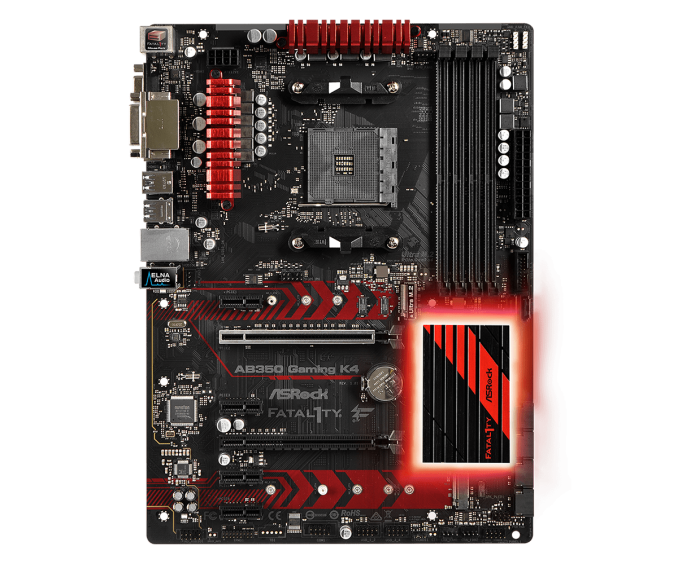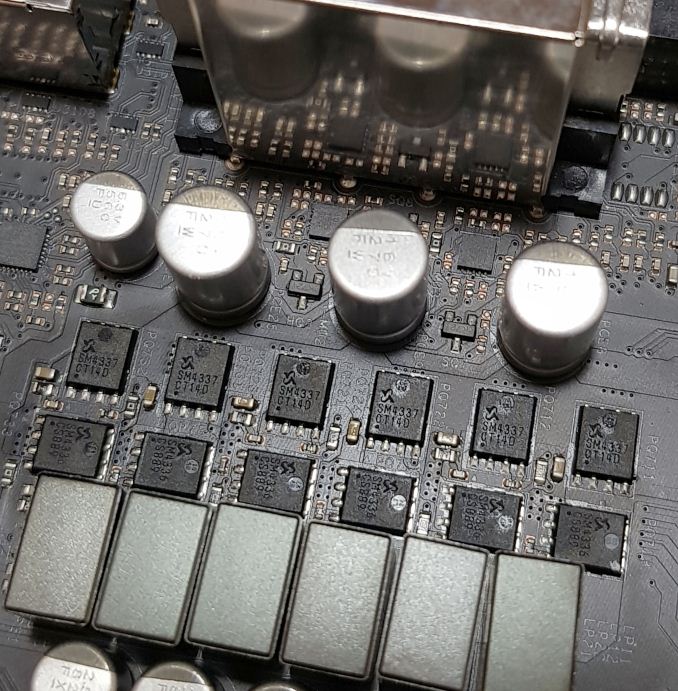The ASRock AB350 Gaming K4 Motherboard Review: Dual M.2 at $90
by Gavin Bonshor on April 9, 2018 9:00 AM ESTASRock AB350 Gaming K4 Conclusion
The ASRock AB350 Gaming K4 is specifically aimed at gamers on the cheaper side of the market: those who only need a single GPU and stndard functionality. ASRock gets straight to the heart of the matter here, having a single PCIe 3.0 x16 slot that is reinforced, ready to take on any triple-slot behemoth that was purchased with the $$$ saved. The key headlines about B350 boards is price: if you can forgo SLI, are happy with 'standard' audio and networking, only need four SATA ports, and don't need USB 3.1 10 Gbps ports (as in this case, but the chipset supports them), then that extra money can be focused elsewhere for a gaming build.
In regards to the performance, there wasn’t any problems or irregularities during testing and I’m more than happy with the quality and fluidity of the BIOS. It’s clear that ASRock has made the AB350 Gaming K4 for gamers wanting an affordable Ryzen based system, but without capitulating the B350 chipset with bargain basement or inadequate components. The power delivery might not be the most potent of layouts, but it was more than adequate to keep an eight-core Ryzen 7 1700 with a modest overclock without having to worry about it. This is due to the Intersil ISL95712 PWM controller, which is found on other boards including the GIGABYTE AB350 Gaming 3 ($80) and even the ASRock X370 Gaming ITX/ac ($180) motherboard. The power delivery operates in an 8+3 configuration and is complimented by Sinopower SM4336 and SM4337 MOSFETs which makes up the bulk of space in the VRM area.
The AB350 Gaming K4 has a total of four native SATA 6Gb/s ports with support for RAID 0, 1 and 10, and another two ports from an ASMedia controller. In addition to the SATA, the board has two M.2 slots, which is impressive to find on such a value focused motherboard. Of course, the caveat here is the top M.2 slot does share bandwidth with the bottom PCIe x4 slot, and the second M.2 is SATA only.
One thing I would like to see included is an easy connector for the front panel pins, as the onboard guide is not as simple as it first appears. If the user is not entirely familiar with the pin out, the manual would be a great starting point, which means digging it out of the box (and so few people look at the manual anyway). The patience of people seems to be getting thinner and thinner within the building community and time saving devices such as an easy connector could enhance the users overall experience.
The BIOS on the AB350 Gaming K4 is very intuitive to enthusiasts, and enables enough overclocking options for those with experience to get to grips. Unfortunately, for users not so confident, there are no automatic overclocking methods featured, other than XMP. This board can accommodate DDR4 RAM up to a total capacity of 64GB (four 16GB modules) with speeds supported up to a maximum of DDR4-3200. This isn’t the theoretical limit on Ryzen for memory, but this will entirely depend on the integrated memory controller of the processor.
With a focus on value, ASRock has indeed included a single USB 3.0 Type-C port, enabled by an ASMedia ASM1543 redriver, as well as five USB 3.0 Type-A ports. For users investing in the new Ryzen Raven Ridge APUs, ASRock has supplied a HDMI port, a DVI-D port and a VGA port.
Audio wise, this board has a Realtek ALC892 codec, which gives the rear panel a total of three 3.5mm jacks; the ALC892 codec doesn’t support the use of a S/PDIF output, but on a board targeted directly at budget gamers, this can be forgiven. Finishing off the rear panel is a single Gigabit Ethernet (RJ45) port controlled by the Realtek RTL8111GR Gigabit controller.
The ASRock AB350 Gaming K4 has enough to make it a very worthwhile purchase for gamers with single graphics cards wanting to save a bit of money over the X370 chipset, but without sacrificing much in the way of onboard qualities. There are a few options that perhaps wouldn't go amiss, such as USB 3.1 support, but the motherboard at this price certainly has no issue keeping up in 24/7 performance with the best of them.













43 Comments
View All Comments
jhensjh - Tuesday, April 10, 2018 - link
Here's a couple typos for a start: "it compounts the issue.", "controllers, which which is to be expected". This article ranges from rambling sentences with excessive comma splices to bordering on nonsensical. An example of the former:"For manual overclocks, based on the information gathered from previous testing, starts off at a nominal voltage and CPU multiplier, and the multiplier is increased until the stability tests are failed."
And the latter:
"This would empty more thermal energy into the heatsinks"
vkristof - Tuesday, April 10, 2018 - link
I want to thank the author for starting to address WHY socket AM4 motherboard manufacturers do not promote/use/whatever the USB 3.1 Gen 2 ports that the AMD chipset supports.However, I assume there's at least one typo in his statement "Despite the chipset supporting USB 3.1 (10 Gbps), ASRock saves some effort in the mode complicated traces by relying on USB 3.0 instead". I assume "mode complicated" should be "MORE complicated" traces. Or?
In addition, why do they plop Asmedia USB 3.1 Gen2 controllers on some of these motherboards to provide gen 2 speeds?
I assume the Asmedia controllers require the same 10+ Gbps differential pair trace routing rules that the B350 chip does. Unless the B350 serdei are less forgiving? Or routing the 10+ Gbps pairs to the high ball count B350 requires more PCB layers?
Anyway, thanks.
Round - Tuesday, April 10, 2018 - link
"If you see any errors or typos, please by all means let us know."LOL. I appreciate the articles, but you've got to be joking, right? You don't see them? They're legion. Besides those already pointed out, take a gander at this gem...
"In regards to the performance, there wasn’t any problems or..."
I'm surprised (and sadly appalled) that it has to be pointed out, but your statement
"Time is fleeting and Google cares more about who's first than who's best..."
is a weak excuse, and nothing more. Anyone can spend 5-10 minutes before publishing. What passes for writing today has me convinced we're ready to collapse into the second coming of the dark ages, where people can't form structured sentences, don't understand tenses, plurals and possessives, or the use of adjectives and adverbs.
Glock24 - Tuesday, April 10, 2018 - link
If this was an article published on the day the media embargo expires for a new product launch I would understand the hurry to publish and lack of proper editing, but this board was launched to the market like a year ago. So why the hurry?Aspernari - Tuesday, May 8, 2018 - link
So a month later, and the editing staff and users haven't managed to catch this:"but this means the onboard audio usese the Realtek RTL8111 networking chip and the Realtek ALC892 audio codec"
A) No, it means the onboard audio is the Realtek ALC892 chipset, and the networking chip is the Realtek RTL8111. We're in deep trouble if the onboard audio is using the RTL8111.
B) It doesn't usese anything. How did that pass basic spellcheck?
PeachNCream - Tuesday, April 10, 2018 - link
Purch generates income from catching and keeping an audience that regularly visits the sites it publishes. It's against the financial interests of the company to drain AnandTech and sell it off when it dies and it's silly to imply that's happening now.In the case of this review, I'm glad to see there are mid-priced motherboards getting a little attention and it's really nice to see something other than a MSI x299 board for once since there's been quite a few of them rolling through of late.
Tewt - Tuesday, April 10, 2018 - link
I thought that must of been a mistake as well. The time for a consumer to research these motherboards that haven't been reviewed yet is nearly over so what is even the point? I had just assumed Anandtech has had a review of the ASRock X370 Taichi board for some time. I will be researching AMD 2000 cpus and 400 series boards in the next few months not older 300 series. /scratches head at Anandtech timelineRyan Smith - Tuesday, April 10, 2018 - link
Let me put things this way: we wouldn't have taken the time to review this board if we didn't think it would be relevant in the future...neogodless - Tuesday, April 10, 2018 - link
That's brilliant! (I've been strongly considering this board and a Ryzen 1700, but I've put it off long enough to wait and see what Ryzen 2xxx brings to the table (and for RAM to, like, not even bankrupt me.) Also I live near Microcenter where this board is just $50 w/ a Ryzen...Ratman6161 - Wednesday, April 11, 2018 - link
Except...one critical thing is missing in the article in the discussion of the 2200g or 2400G. That is that if you buy this motherboard, or any other existing motherboard you are taking a crap shoot on weather you will get a board that has a bios that will support the newer processor. I was considering a 2200g build for my wife until I realized that to make it work, I'd probably have to pull the R51600 out of my system and put it in the new board just so I could update the bios...or give her the motherboard from my system since that's already updated. I decided it would be easier for me to just wait a bit for the newer motherboards to come out.I too live near a Microcenter...gotta love it!